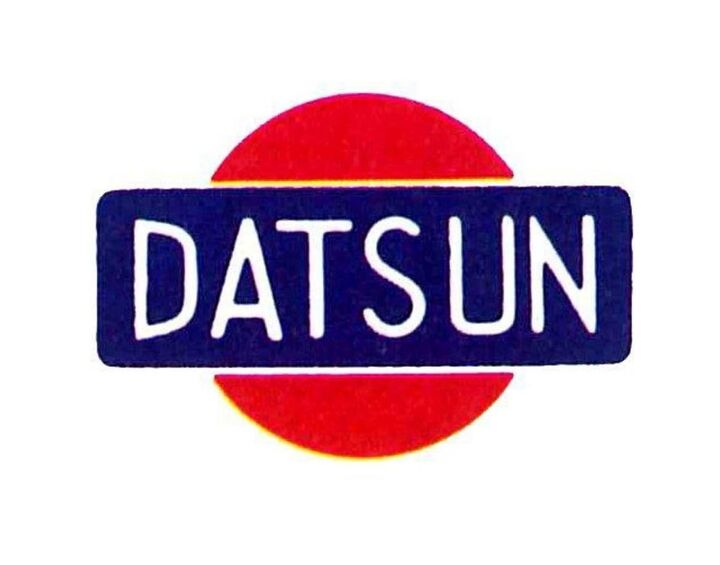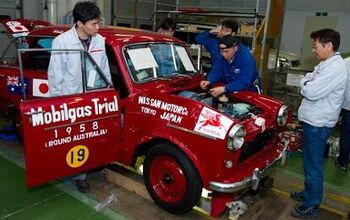Datsun is Dead Again

Datsun is dead again and the likelihood of you having any emotions tied to the matter hinges upon whether or not you were driving prior to the 1990s. Formerly a catch-all brand for Nissan’s exports, the automaker eventually decided to unify its products under a single name when Ronald Reagan was in the White House and Max Headroom was talking up the merits of New Coke on cathode-ray tubed televisions.
While the Datsun moniker would grace the odd pickup on the Japanese domestic market after the 1980s, Nissan planned a compressive relaunch of the brand in 2013. The following year, Datsun became a low-cost car marque for Indonesia, Nepal, South Africa, India, and Russia. A few years later, Kazakhstan, Belarus, and Lebanon were added to the brand’s list of markets. However, Datsun had announced a retreat from Indonesia and Russia in 2019 and has since confirmed that it will be halting production in India later this year — effectively ending Datsun’s existence once again.
Up until 1986, just about everything Nissan exported to the United States carried the Datsun name. The moniker can be traced back to the 1920s, when the business was known as DAT Motors, and would not become Nissan until the brand had reached true zaibatsu status and started focusing on building larger, American-style vehicles in the late 1930s. While the Datsun name stuck around, it gradually became known for the smaller non-truck models before shipping out its first batch of exports to the United States in 1958.
By this time, the automaker’s products had taken a more European approach to automobiles due to its relationship with the Austin — specifically in relation to the Datsun 1000 (210). By the 1960s, the company was establishing factories around the world to help with its worldwide expansion. Nissan elected to begin phasing out the Datsun name in 1981 after leadership decided it would be easier to market products globally under a single banner.
Ironically, the Datsun name would remain more recognizable for several years in the U.S. — though not for a lack of effort. During those interim years, Nissan launched an extensive ad campaign to explain the rebranding. Cars even left the factory with small Nissan badges for a few years to help ease the public into the transition. But this arguably made things even more confusing. New models (e.g. Sentra) were often given the Nissan prefix while older cars had a better chance of sticking around for a few years before officially becoming Nissan products. This often resulted in lots full of vehicles that were labeled as Datsun, Nissan, or “Datsun by Nissan.”
In this way, Nissan kind of became the New Coke of automakers. Much in the way Coca-Cola got spooked by Pepsi, Datsun became worried that Honda and Toyota had gained a competitive advantage by nature of having a single name for all regions. Swapping to the Nissan badge is estimated to have cost the company hundreds of millions of dollars. Despite delivering increasingly good products, consumers became confused and assumed the change had been made out of desperation — again, mimicking what happened with New Coke.
The only difference is that New Coke became Coke II (which I recall tasting great) before being discontinued in 2002, whereas Datsun stayed Nissan until it reemerged as a new subsidiary in 2013.
Production at the Renault-Nissan plant in Chennai, India, has officially ended. That means the Renault-based Datsun Go has followed the AvtoVAZ-built Datsun mi-Do (Lada Kalina) and on-Do (Lada Granta) into oblivion. Though there are conflicting reports about exactly when individual Go models were discontinued. Autocar India reported that production had all but ended at the start of 2021, with the Redi-Go being the final vehicle to get the ax. Considering the manufacturer didn’t even reach 5,000 deliveries for the market last year, it’s easy to see why Nissan pulled out.
The entire industry has also been prioritizing higher-margin (more expensive) vehicles in a bid to improve profitability during an inflationary period — or at least until it sees customers getting tired of paying more for vehicles. Though Nissan left its official statement pretty basic.
“As part of Nissan’s global transformation strategy, the company is focusing on core models and segments that bring the most benefit to customers, dealer partners and the business. Production of the Datsun Redigo has ceased at the Chennai plant,” it explained.
Datsun customers will allegedly be taken care of. They’ll simply have to get their vehicles serviced at Nissan dealerships, with the company confirming that existing warranties will be honored.
“We can reassure all existing and future Datsun owners that customer satisfaction remains our priority, and we will continue to provide the highest levels of aftersales service, parts availability and warranty support from our national dealership network,” stated the automaker.
[Images: Nissan; S.Candide/Shutterstock]

A staunch consumer advocate tracking industry trends and regulation. Before joining TTAC, Matt spent a decade working for marketing and research firms based in NYC. Clients included several of the world’s largest automakers, global tire brands, and aftermarket part suppliers. Dissatisfied with the corporate world and resentful of having to wear suits everyday, he pivoted to writing about cars. Since then, that man has become an ardent supporter of the right-to-repair movement, been interviewed on the auto industry by national radio broadcasts, driven more rental cars than anyone ever should, participated in amateur rallying events, and received the requisite minimum training as sanctioned by the SCCA. Handy with a wrench, Matt grew up surrounded by Detroit auto workers and managed to get a pizza delivery job before he was legally eligible. He later found himself driving box trucks through Manhattan, guaranteeing future sympathy for actual truckers. He continues to conduct research pertaining to the automotive sector as an independent contractor and has since moved back to his native Michigan, closer to where the cars are born. A contrarian, Matt claims to prefer understeer — stating that front and all-wheel drive vehicles cater best to his driving style.
More by Matt Posky
Latest Car Reviews
Read moreLatest Product Reviews
Read moreRecent Comments
- FreedMike Not surprisingly, I have some ideas. What Cadillac needs, I think, is a statement. They don’t really have an identity. They’re trying a statement car with the Celestiq, and while that’s the right idea, it has the wrong styling and a really wrong price tag. So, here’s a first step: instead of a sedan, do a huge, fast, capable and ridiculously smooth and quiet electric touring coupe. If you want an example of what I’m thinking of, check out the magnificent Rolls-Royce Spectre. But this Cadillac coupe would be uniquely American, it’d be named “Eldorado,” and it’d be a lot cheaper than the $450,000 Spectre – call it a buck twenty-five, with a range of bespoke options for prospective buyers that would make each one somewhat unique. Make it 220 inches long, on the same platform as the Celestiq, give it retro ‘60s styling (or you could do a ‘50s or ‘70s throwback, I suppose), and at least 700 horsepower, standard. Why electric? It’s the ultimate throwback to ‘60s powertrains: effortlessly fast, smooth, and quiet, but with a ton more horsepower. It’s the perfect drivetrain for a dignified touring coupe. In fact, I’d skip any mention of environmental responsibility in this car’s marketing – sell it on how it drives, period. How many would they sell? Not many. But the point of the exercise is to do something that will turn heads and show people what this brand can do. Second step: give the lineup a mix of electric and gas models, and make Cadillac gas engines bespoke to the brand. If they need to use generic GM engine designs, fine – take those engines and massage them thoroughly into something special to Cadillac, with specific tuning and output. No Cadillac should leave the factory with an engine straight out of a Malibu or a four-banger Silverado. Third step: a complete line-wide interior redo. Stop the cheapness that’s all over the current sedans and crossovers. Just stop it. Use the Lyriq as a blueprint – it’s a big improvement over the current crop and a good first step. I’d also say Cadillac has a good blend of screen-controlled and switch-controlled user interfaces; don’t give into the haptic-touch and wall-to-wall screen thing. (On the subject of Caddy interiors – as much as I bag on the Celestiq, check out the interior on that thing. Wow.)Fourth step: Blackwing All The Things – some gas, others electric. And keep the electric/gas mix so buyers have a choice.Fifth step: be patient. That’s not easy, but if they’re doing a brand reset, it’ll take time.
- NJRide So if GM was serious about selling this why no updates for so long? Or make something truly unique instead of something that looked like a downmarket Altima?
- Kmars2009 I rented one last fall while visiting Ohio. Not a bad car...but not a great car either. I think it needs a new version. But CUVs are King... unfortunately!
- Ajla Remember when Cadillac introduced an entirely new V8 and proceeded to install it in only 800 cars before cancelling everything?
- Bouzouki Cadillac (aka GM!!) made so many mistakes over the past 40 years, right up to today, one could make a MBA course of it. Others have alluded to them, there is not enough room for me to recite them in a flowing, cohesive manner.Cadillac today is literally a tarted-up Chevrolet. They are nice cars, and the "aura" of the Cadillac name still works on several (mostly female) consumers who are not car enthusiasts.The CT4 and CT5 offer superlative ride and handling, and even performance--but, it is wrapped in sheet metal that (at least I think) looks awful, with (still) sub-par interiors. They are niche cars. They are the last gasp of the Alpha platform--which I have been told by people close to it, was meant to be a Pontiac "BMW 3-series". The bankruptcy killed Pontiac, but the Alpha had been mostly engineered, so it was "Cadillac-ized" with the new "edgy" CTS styling.Most Cadillacs sold are crossovers. The most profitable "Cadillac" is the Escalade (note that GM never jack up the name on THAT!).The question posed here is rather irrelevant. NO ONE has "a blank check", because GM (any company or corporation) does not have bottomless resources.Better styling, and superlative "performance" (by that, I mean being among the best in noise, harshness, handling, performance, reliablity, quality) would cost a lot of money.Post-bankruptcy GM actually tried. No one here mentioned GM's effort to do just that: the "Omega" platform, aka CT6.The (horribly misnamed) CT6 was actually a credible Mercedes/Lexus competitor. I'm sure it cost GM a fortune to develop (the platform was unique, not shared with any other car. The top-of-the-line ORIGINAL Blackwing V8 was also unique, expensive, and ultimately...very few were sold. All of this is a LOT of money).I used to know the sales numbers, and my sense was the CT6 sold about HALF the units GM projected. More importantly, it sold about half to two thirds the volume of the S-Class (which cost a lot more in 201x)Many of your fixed cost are predicated on volume. One way to improve your business case (if the right people want to get the Green Light) is to inflate your projected volumes. This lowers the unit cost for seats, mufflers, control arms, etc, and makes the vehicle more profitable--on paper.Suppliers tool up to make the number of parts the carmaker projects. However, if the volume is less than expected, the automaker has to make up the difference.So, unfortunately, not only was the CT6 an expensive car to build, but Cadillac's weak "brand equity" limited how much GM could charge (and these were still pricey cars in 2016-18, a "base" car was ).Other than the name, the "Omega" could have marked the starting point for Cadillac to once again be the standard of the world. Other than the awful name (Fleetwood, Elegante, Paramount, even ParAMOUR would be better), and offering the basest car with a FOUR cylinder turbo on the base car (incredibly moronic!), it was very good car and a CREDIBLE Mercedes S-Class/Lexus LS400 alternative. While I cannot know if the novel aluminum body was worth the cost (very expensive and complex to build), the bragging rights were legit--a LARGE car that was lighter, but had good body rigidity. No surprise, the interior was not the best, but the gap with the big boys was as close as GM has done in the luxury sphere.Mary Barra decided that profits today and tomorrow were more important than gambling on profits in 2025 and later. Having sunk a TON of money, and even done a mid-cycle enhancement, complete with the new Blackwing engine (which copied BMW with the twin turbos nestled in the "V"!), in fall 2018 GM announced it was discontinuing the car, and closing the assembly plant it was built in. (And so you know, building different platforms on the same line is very challenging and considerably less efficient in terms of capital and labor costs than the same platform, or better yet, the same model).So now, GM is anticipating that, as the car market "goes electric" (if you can call it that--more like the Federal Government and EU and even China PUSHING electric cars), they can make electric Cadillacs that are "prestige". The Cadillac Celestique is the opening salvo--$340,000. We will see how it works out.





































Comments
Join the conversation
Reminds me of back in the seventies, when Nissan sent a planeload of parts to the US but the cargo door wasn't closed. It was raining Datsun cogs.
Nissan only seems to be memorable as the company that makes Altimas that are destined to be driven aggressively on the freeway while in rather poor condition. If they could bring back the Datsun name, attach good products to it, and give the Nissan brand a viking funeral, it would be for the best.